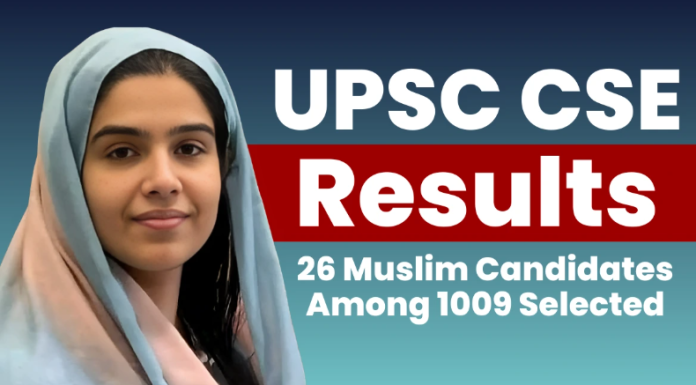– Mohd. Naushad Khan
Every time, after the UPSC Civil Services Examination results are announced, attention is drawn to the number of Muslim candidates who qualify and their percentage is widely debated but without serious rethinking on it.
The results of the UPSC examinations have left the Muslim community disheartened this year, with only 26 Muslim candidates among the 1,009 who qualified for the prestigious civil services – just 2.5%, despite the community comprising 14.2% of India’s population according to the 2011 Census.
Historically, the proportion of Muslim candidates qualifying for the UPSC has fluctuated between 2% and 5%. Both governmental and non-governmental organizations have long advocated for greater Muslim representation in civil administration. After a brief period of improvement, the numbers have once again declined. In 2019, 44 Muslim candidates – 5.3% of 829 total qualifiers – succeeded. This dropped to 29 candidates (3.1%) out of 933 in 2022. The following year, in 2023, the number rose again to 51 Muslim candidates, representing 5% of the 1,016 total qualifiers.
Experts emphasize that the focus should shift from lamenting low representation to encouraging greater participation. They argue that increased application rates among Muslims will naturally lead to improved outcomes. Without broad participation, representation will continue to fall short.
A notable success this year came from Jamia Millia Islamia’s Residential Coaching Academy (RCA), where 32 candidates qualified for the UPSC Civil Services Exam 2024. Out of 78 RCA students who reached the interview stage, 32 were selected, including 12 women.
Emphasising the need to diversify and expand our strategy for self-empowerment, Dr Syed Zafar Mahmood, former bureaucrat and member of Sachar Commission, said, “In recent years, the gross intake into the civil services through UPSC has been on a downward trend. Seven years ago, the annual recruitment had gone up to 1,250 but three years ago it came down to 650 which again partly rose this year, but the general trend is downwards. Secondly, for the last few years, the government has started making recruitment directly, often from the corporate sector, at the senior level of Joint Secretary to the Government of India; this is known as a lateral entry. Thirdly, there’s no denying the fact that currently the general ecosystem is also not very conducive.”
He added, “The solution lies in diversifying and expanding the strategy mulling over the other possible areas of self-empowerment. There are 29 state/UT public service commissions and 25 High Courts that make annual recruitment in large numbers. The central staff selection commission recruits tens of thousands every year. UPSC itself makes block recruitments other than civil services,” he said.
He maintained, “For many of such services the basic qualification is class 12th and often there is only written examination, no interview. We need to reach out to the boys and girls, inform them, inspire them and facilitate their preparation for such competitive examinations. Zakat Foundation of India has been doing this work also, for three years, through several online and offline programmes.”
On ZFI efforts, he said, “ZFI provides online lectures for students of class 9th to 12th one hour per day, three days in a week. For this purpose, it reaches out to the community-run schools requesting them to earmark one room with projector and screen. This programme sensitises the students about the government openings after class 12th and prepares them well in advance so that after passing class 12th they get selected for a government position in the first attempt. Having joined the government, later they may even choose to improve their academic credentials as well as further rise in the government hierarchy by appearing at other competitive examinations, including the UPSC civil services.”
According to Mohammad Tarique, former Director of JMI-RCA, “Muslims’ representation is poor in all All-India services, Central Services, State Services and PSUs due to their overall socio-economic background. But few more factors have been responsible:
- With so many lakhs of Muslim graduates, why only few prepare and appear in competitive examinations? Many do not have big dreams, many do not get good opportunities like coaching and guidance.
- Most young educated Muslims look for instant job rather than putting some efforts post-college to get a better job.
- They do not have culture and tradition, since long, in their family and near relatives to prepare for competitive examinations unlike some other communities and region.
- Muslim educational institutions which could have provided better guidance are in poor hands who do not have vision and passion. Muslim intellectuals, by and large, have abandoned their community. They do not guide and give hand holding to them.
- Jamia Millia Islamia or earlier Hamdard Study Circle could produce some better results because they had, in their initial stage of formation some very knowledgeable and committed people like Syed Hamid (IAS) and Prof. Usman Adhami in HSC, Mr. Najeeb Jung (IAS), Prof. Anisur Rahman, and Mr. M.F. Farooqui in Jamia who made an excellent ecosystem, filtered better raw material and polished them. But the tempo could not be maintained there too.
“For better result Muslim organisations, educational institutions should establish Residential Coaching Institutes like JMI, HSC, Patna Hajj House and should appoint right people. Muslim graduates should be motivated and guided all across the country to appear in large numbers to make their presence. They need to have fire in their belly,” he said.
Professor Saghir Ansari, former Director of AMU’s RCA, offered an analysis of AMU’s underperformance. He identified a lack of awareness, low motivation, and preference for traditionally “safe” professional courses like medicine and engineering as key factors. Students often opt for quick employment opportunities due to financial needs, avoiding the uncertainty associated with competitive exams like UPSC.
Ansari also noted that many bright students shy away from civil services due to fear of failure, poor planning, and inadequate strategic preparation. Additionally, he pointed out that female students at AMU show great potential but require encouragement and support to take up this challenge. He suggested that awareness and training should start from high school, and that misconceptions about civil services must be addressed.
The discourse on Muslim representation in civil services needs a significant shift – from counting the number of successful candidates to increasing participation, building institutional support, and creating a culture of motivation and preparation. As highlighted by experts, the road to better representation lies not in lamenting over numbers but in proactive planning, investment in quality coaching, and encouraging students from all backgrounds to aim high and persist through challenges.




